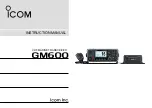
23
Sabine 2.4 GHz Smart Spectrum
®
Wireless
LIT-SWM7000-OG-EN-070615.pmd - rr
© 2007 Sabine, Inc.
transmitter to receiver, expands and focuses antenna sensitivity, and al-
lows antenna and receiver to be positioned further apart or in separate
rooms.
2.
Decide on front or rear panel antenna mounting (to maintain line-of-
sight path). Antennas typically mount on the rear panel of your receiver,
but the included accessory SWA700 front mounting kit can be screwed
onto the front and connected via jumper to the back panel terminals. When
mounting receivers in a rack that is deeper than the receiver, move the
antennas to the front for improved reception. For any rack mounted re-
ceiver, try to keep the top 1.25 “ (3 cm) of both antennas extended outside
the sides of the rack (see Fig. 5h). Non-rack mounted receivers should be
oriented so that the antennas face the transmitters.
3.
Maximize the distance between the receiver and light sources, such as
fluorescent bulbs or neon signs, which may emit very short-range, broad-
band interference. These light sources should not be a problem in normal
circumstances, but, as a cautionary preventative, we recommend a mini-
mum distance of 3 meters (10 feet) between them and any receivers or
extension antennas.
4.
Note the placement of any microwave ovens in the immediate vicinity.
Place any receivers or extension antennas as far away as is practical from
microwave ovens.
5.
Mount receiver antennas at 90 degrees to one another, leaning away
at 45 degree angles, in the same plane. This will decrease the likelihood
that one antenna will be susceptible to the same orientation-specific direc-
tional or multi-path problems that may affect the other one.
6.
When using multiple receivers, try to maintain at least 1 foot (30 cm)
distance between antennas from different units. If you are rack-mount-
ing multiple receivers, you may want to avoid spacing them in adjacent
rack spaces, to maintain distance between antennas. When such antenna
spacing proves difficult or impossible, we recommend using Sabine’s An-
tenna Distribution Amplifier (Sabine SWA6SS), which can help manage
antenna configurations and, more importantly, improve system-wide inter-
ference rejection. The SWA6SS works with up to six receivers.
7.
In very rare instances, poorly shielded or malfunctioning computers or
digital effects units may cause RF interference. You can test whether
such units are the sources of such interference by switching them off one
at a time, and determining if interference rejection improves.
8.
Turn on your system one component at a time, beginning with the first
receiver. If you don’t have a computer handy, keep all other receivers and
transmitters switched off for the time being.
9.
Use the RF Scan function included in the Remote Control Software.
This will give you a picture of the potential interference in your area, both
real-time and over time. Please refer to Section 13.4.2.5. for information on
Sabine Remote Control Software’s Automatic RF Scan function, which will
automatically determine the best RF channels to use.
10. Maintain a minimum distance of at least 3 meters (10 feet) between
transmitters and receivers or extension antennas. This can solve many
anomalies.
11. Be careful not to set more than one transmitter to the same channel;
each paired transmitter and receiver should be set to unique correspond-
ing channels, until all channels are receiving clearly and cleanly.
12. Once the physical placement of your receiver(s) and antenna(s) is de-
cided, proceed with the remainder of the setup process.
Receiver Operation
















































